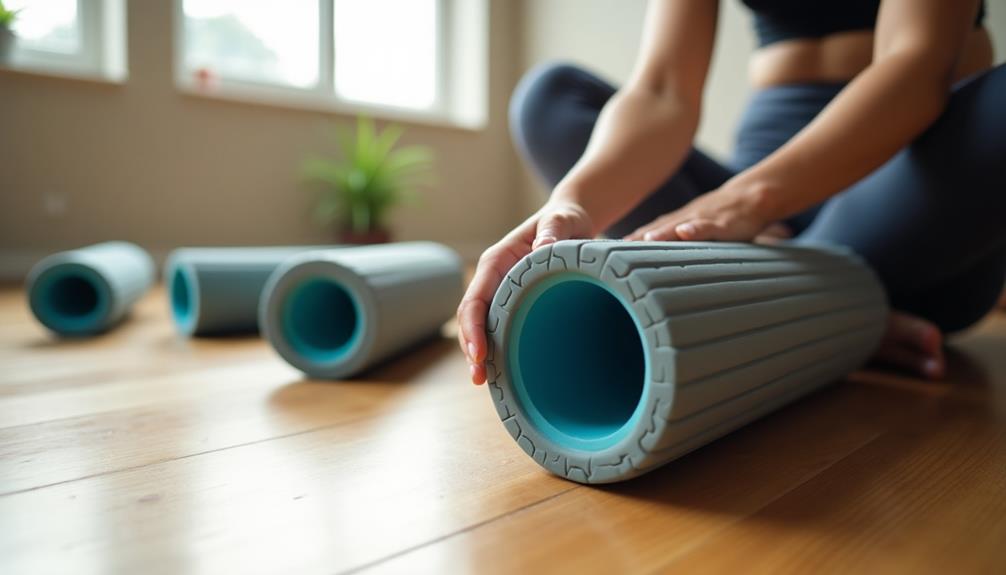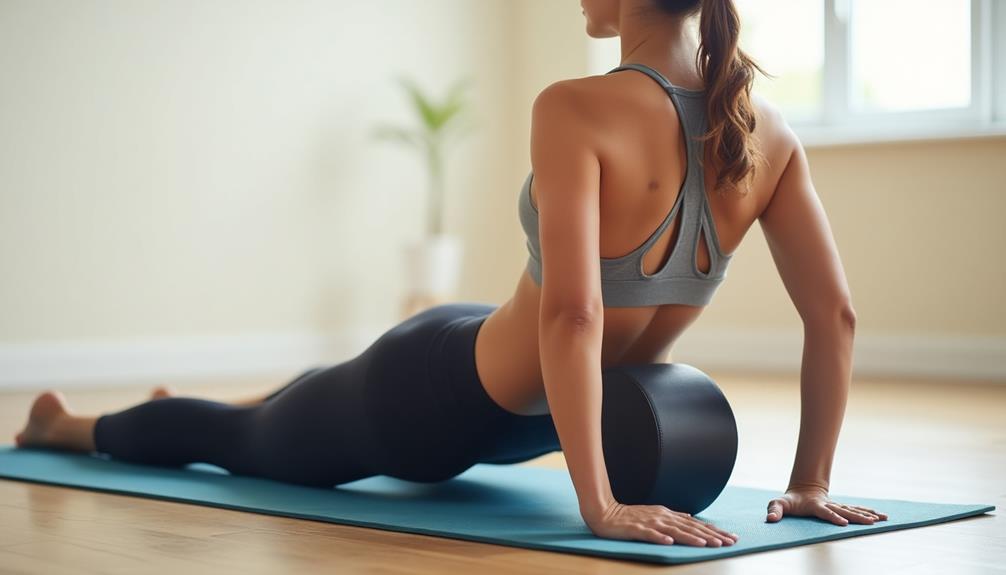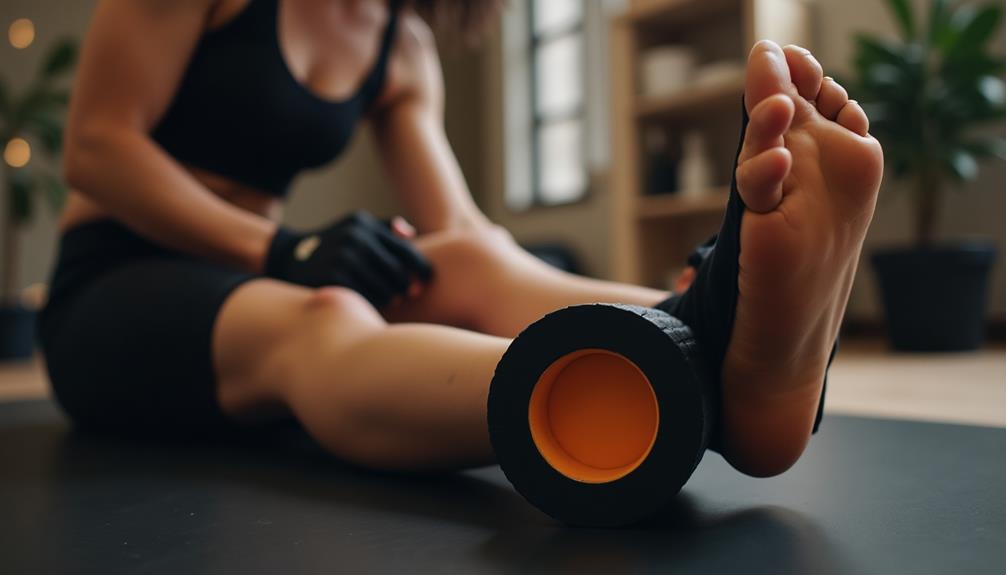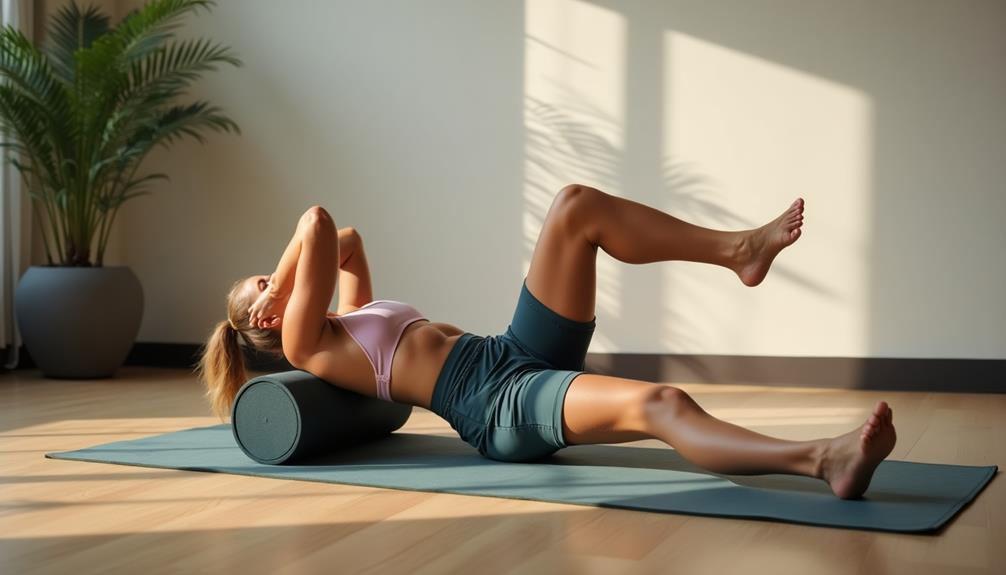To soothe sore muscles with foam rolling, follow these seven steps. First, choose the right foam roller based on density, size, and texture. Next, warm up by maintaining steady pressure while rolling and breathing deeply. Then, target key muscle groups like calves and quadriceps for effective relief. Apply proper technique by using body weight and rolling slowly for 30 seconds to two minutes. Control your breathing to calm your nervous system as you roll. Adjust pressure and duration based on comfort. Finally, incorporate foam rolling into your routine for lasting benefits. There's more to uncover on optimizing your technique.
Core Insights
- Choose a foam roller with appropriate density; softer for beginners and firmer for deeper tissue massage.
- Warm up muscles by rolling for 30 seconds to two minutes, maintaining steady pressure and deep breathing.
- Focus on key muscle groups like calves, quadriceps, and back to alleviate tension effectively.
- Use proper technique by positioning the roller correctly and engaging your core for stability.
- Coordinate your breathing with rolling movements, inhaling deeply and exhaling slowly to enhance relaxation and release tension.
Choose the Right Foam Roller

When you're picking a foam roller, it's important to take into account your specific needs and preferences. Start by considering the density of the roller. Softer rollers are great for beginners or those with sensitivity, while firmer options provide deeper pressure for experienced users. High-density foam rollers are particularly effective for deep tissue massage and myofascial release. Some rollers even feature textured surfaces that mimic massage therapists' hands for targeted pressure. Next, think about size and shape. A longer roller covers larger muscle groups, while smaller, targeted rollers can focus on specific areas like knots or tight spots. Textured rollers offer additional stimulation, enhancing your experience. Finally, consider portability if you plan to use it on the go. By evaluating these factors, you'll be better equipped to choose a foam roller that suits your workout routine and helps reduce muscle soreness effectively.
Warm Up Your Muscles

As you roll, uphold a steady pressure, allowing the foam roller to work through knots and tension. Remember to breathe deeply, which helps relax your muscles further. For best outcomes, select a deep tissue foam roller that suits your specific needs and comfort level. This will guarantee you target the correct areas effectively. A proper warm-up not only enhances performance but also diminishes the risk of injury. So, take the time to roll out and get your body ready for action!
Target Key Muscle Groups

To effectively target key muscle groups, focus on areas that often hold tension and soreness, like your calves, quadriceps, and back. Start with your calves; roll from your Achilles tendon to the back of your knees. This helps release tightness and improves flexibility. Next, move to your quadriceps. While lying face down, position the foam roller under your thighs, rolling from your hips to your knees. This can alleviate tightness from activities such as running or cycling. Using a high-density foam roller can provide firm compression for deeper tissue massage, enhancing the effectiveness of your rolling routine. These rollers are particularly beneficial for targeting larger muscle groups and supporting muscle recovery. Finally, don't forget your back. Place the roller beneath your upper back and gently roll down to your lower back. This helps relieve stress and tension built up throughout the day. By concentrating on these key areas, you can enhance your recovery and overall performance.
Apply Proper Technique

Applying proper technique is essential for maximizing the benefits of foam rolling and minimizing the risk of injury. Start by positioning the foam roller under the targeted muscle group. Use your body weight to apply pressure, rolling slowly over the area for 30 seconds to two minutes. Focus on spots that feel tight or sore, but avoid rolling directly over bones or joints. Maintain a steady pace; moving too quickly can reduce effectiveness. Adjust your body position to target different angles, ensuring thorough coverage of the muscle. Remember to keep your core engaged for stability and support. Finally, listen to your body—if you experience sharp pain, ease off and reassess your technique.
Control Your Breathing

- Inhale Deeply: Take slow, deep breaths in through your nose, filling your lungs. This helps to calm your nervous system.
- Exhale Slowly: Let your breath out gently through your mouth. This releases tension as you roll over tight spots.
- Match Your Breath with Movement: Coordinate your breathing with your foam rolling rhythm. For instance, inhale as you prepare to roll and exhale as you apply pressure.
Adjust Pressure and Duration

Often, adjusting pressure and duration during foam rolling can greatly enhance your recovery process. Start by finding a comfortable position on the foam roller. Apply just enough pressure to feel a slight discomfort, but not pain. Gradually increase the pressure as your muscles respond.
When it comes to duration, rolling for 30 seconds to 1 minute on each muscle group is effective. If you find a particularly tight spot, spend a little extra time there.
Here's a simple guide to help you adjust pressure and duration:
| Pressure Level | Duration |
|---|---|
| Light (1-3/10) | 30 seconds |
| Moderate (4-6/10) | 45 seconds |
| Firm (7-9/10) | 1 minute |
| Intense (10/10) | 1-2 minutes (briefly) |
Incorporate Foam Rolling Regularly

To truly benefit from foam rolling, you need to make it a regular part of your routine. Consistency is key to experiencing the full effects of this technique. By incorporating foam rolling into your schedule, you can reduce muscle soreness and improve recovery. Here are three simple ways to integrate it into your life:
- Set a Schedule: Aim to foam roll at least three times a week, preferably after workouts or on rest days.
- Create a Rolling Routine: Target specific muscle groups, spending 1-2 minutes on each area to ensure thorough coverage.
- Pair It with Other Recovery Strategies: Combine foam rolling with stretching and hydration for best results.
Regular practice will help you feel more agile and less sore, ultimately supporting your fitness journey.
Frequently Asked Questions
Can Foam Rolling Be Harmful if Done Incorrectly?
Yes, foam rolling can be harmful if you're not careful. Improper technique or excessive pressure can lead to bruising, muscle strain, or injury. It's important to learn the right methods to avoid any negative effects.
How Often Should I Foam Roll Each Week?
You should foam roll about two to three times a week for best results. However, listen to your body; if you're feeling particularly sore, it's okay to increase the frequency temporarily.
Is Foam Rolling Suitable for All Fitness Levels?
Foam rolling's like a warm embrace for tired muscles. It's suitable for all fitness levels, whether you're a novice or a seasoned athlete. Just listen to your body, and you'll reap the benefits.
What Are the Signs of Overdoing Foam Rolling?
If you're overdoing foam rolling, you might notice increased soreness, bruising, or tenderness in the muscles. Fatigue and decreased performance are also signs that you need to give your body a break from rolling.
Can Foam Rolling Help With Injury Recovery?
Think of foam rolling as a magic wand for your muscles. It can aid in injury recovery by increasing blood flow, reducing tension, and promoting flexibility. Just remember to listen to your body while you roll.

